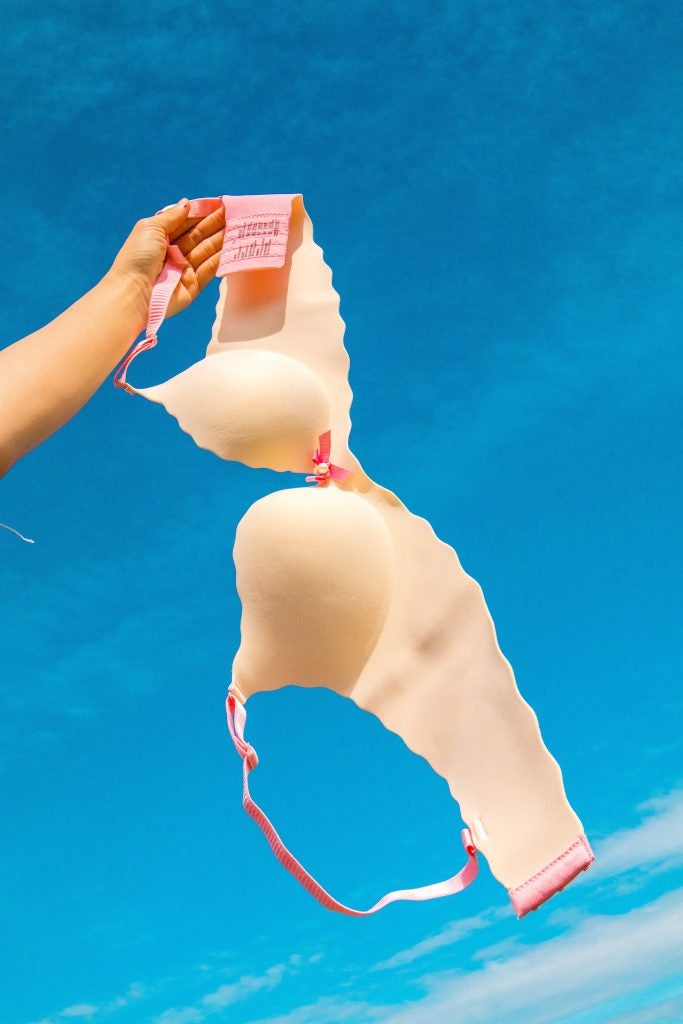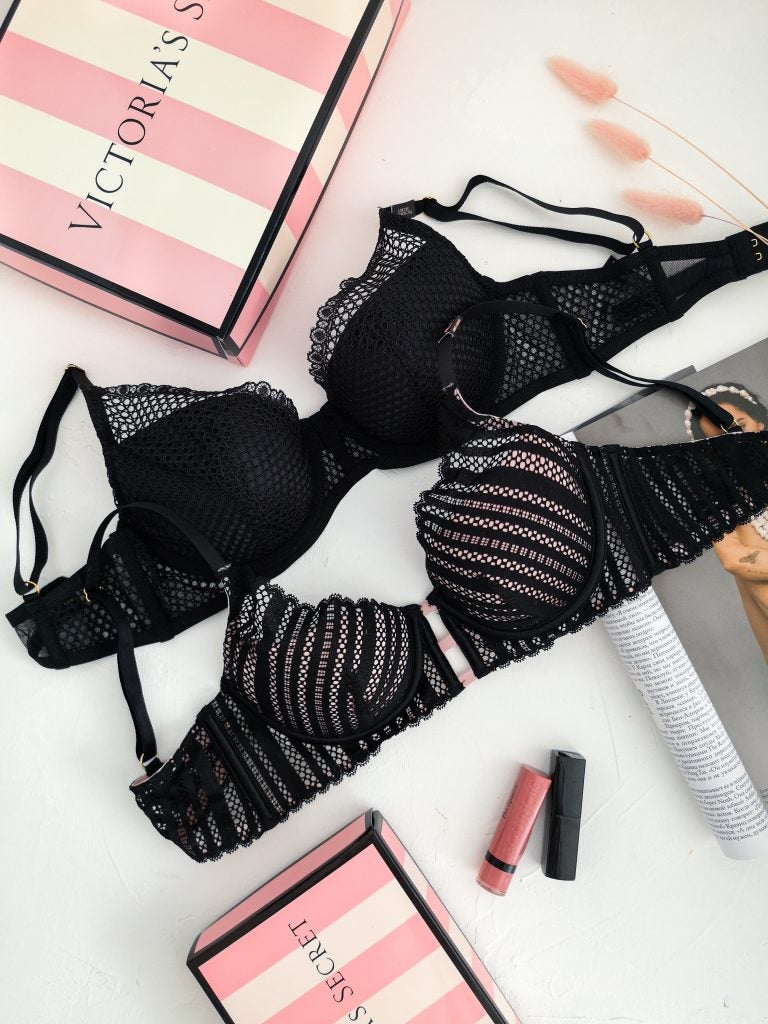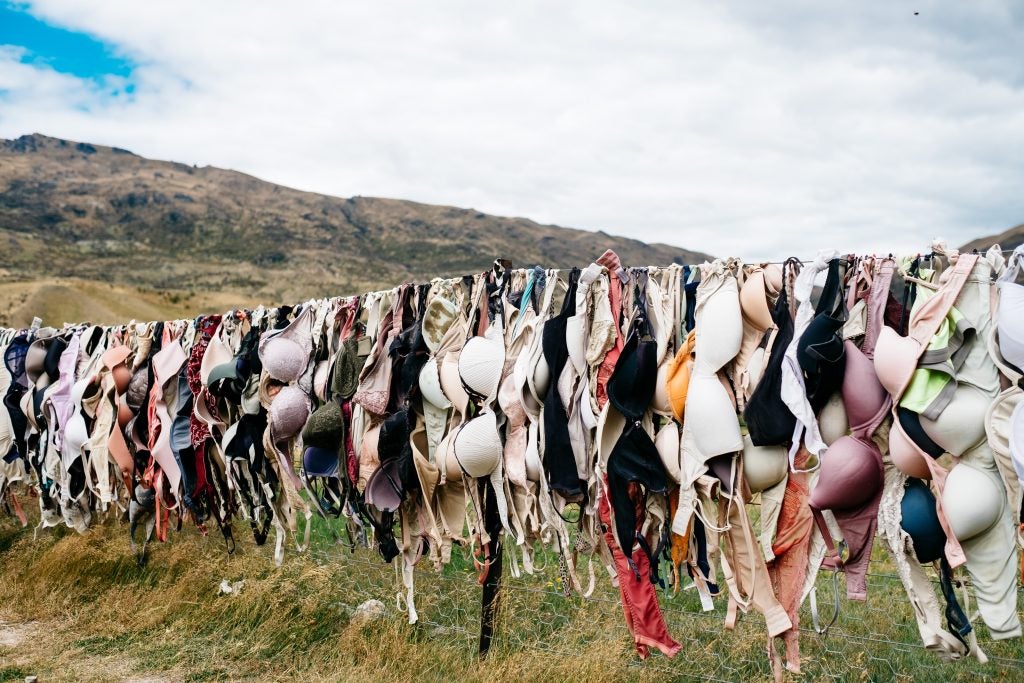
The bra is a supportive undergarment that women all over the world use to relieve back pain, act as a stylish accessory, and accentuate the breasts. A relatively modern invention, the bra has evolved tremendously over the last century from its humble beginnings as a lightweight piece of cloth that replaced the corset. Now, bras are available in a plethora of sizes, styles, and varying levels of support to fit every set of breasts.
Invention
The modern term “bra” is a shortened word for brasserie, which was first used by American Vogue to describe a smaller and simpler corset.1 The first patent for a bra did not develop until 1914, when New York socialite, Mary Phelps Jacob, created the first design of the modern bra. Jacob created her bra because she did not want to wear a constricting and confining corset when she went to large parties and balls.2 She designed this bra as a lightweight, backless garment using two handkerchiefs and a pink ribbon.1 The style resembled a modern-day halter top, as the ribbon was tied around the women’s neck and the handkerchiefs formed cups around the breasts. In comparison to the corset, this bra was far less restraining and allowed females to experience more bodily freedom and relief. Although Jacob’s invention of the bra was revolutionary and provided an alternative to the corset, the majority of females did not wear a bra outside of the house, as society was slow to adapt to this new form of feminine clothing. The bra provided a wonderful alternative to women at home; serving a utilitarian purpose, females were able to completely take off their corsets (not just loosen them), and replace them with a light, loose bra. Mary Phelps Jacob did not gain much fame or fortune from her invention, as she sold the patent rights to The Warner Brothers Corset Company several years later for the modern equivalent of $21,000.2 Without her invention, the development and evolution of women’s undergarments would not have taken place in the same way that they did.
Evolution Timeline
1918 – The demise of the corset came with the beginning of World War I, as Americans were donating every piece of scrap metal and fabric to the war effort. In addition, women had to enter the workforce to replace all of the men who were leaving for the battlefield, and the corset was simply an impractical piece of clothing to wear.2 The bra was deemed a suitable replacement for the awkward metal corset, especially during wartime.
1920s – During a period of affluence and prosperity, women’s clothing became both more lavish and realistic. Wife and husband Ida and William Rosenthal teamed up with Enid Bissett to create a new brand of bra, Maidenform. Maidenform bras had distinguishable cups in an apparatus that was sewn directly into dresses to add support and comfort.2 The acknowledgement of varying cup sizes sparked the beginning of the movement towards gender equality and recognition.
1947-1950 – Frederick Mellinger, the businessman behind Frederick’s of Hollywood, developed the first padded bra in 1947, which increased comfort and style. A year later, he created the first push-up bra, which allowed women to flaunt their breasts with a little extra lift. During this time period, Mellinger also designed the front-hook bra as well as differing colors and styles.2 Mellinger’s contributions to the evolution of the bra helped to transform the bra from a utilitarian garment, to a stylish piece of clothing that could also function as lingerie.
1968 – During the height of the Women’s Liberation movement, women staged a protest outside of the Miss America pageant in Atlantic City. The protest aimed to illuminate the restrictive nature of bras, calling them “instruments of female torture.” In addition to the verbal protest, many women threw out their bras in a garbage can. The initial purpose was to burn the bras in order to emphasize their point, but the police suppressed that form of protest.2 The protest at the Miss America pageant was a major event in the second wave of feminism. Feminists argued that the Miss America pageant was a degrading “cattle parade” that perpetuated the patriarchal construct that confines women to a position of inferiority based on their representation of beauty.3
1977 – This year sparked the development of two major contributors to the evolution of the modern bra: the first sports bra and the creation of Victoria’s Secret. Lisa Lindahl and Polly Smith teamed up with Hinda Miller to develop the first sports bra, which was a makeshift piece of clothing made of two jock straps. Lisa was an avid runner and felt that the bras on the market at that time did not support her breasts like they should. So, her team invented the Jogbra as a bra that women could use as they jogged. In San Francisco, Roy Raymond founded Victoria’s Secret. He felt uncomfortable purchasing lingerie for his wife in stores, so he created his own brand of undergarments.2

1990 – Madonna transformed the bra into a fashion piece with the cone bra she wore for her Blond Ambition tour.2 Madonna was a key figure, in addition to others, who supported the ideal that women should be able to wear whatever they want regardless of beauty standards or judgments. Feminists reclaimed the picturesque version of universal womanhood, high-heels and exposed cleavage included.3
2000 – Victoria Secret continued to stage their infamous annual fashion show, showcasing the fantasy bra: a lavish and beautifully crafted piece of art that one lucky model would be honored to wear on the runway. The fantasy bra gained critical acclaim in 2000 when model Gisele Bundchen modeled the most expensive version of the fantasy bra. She wore the Red Hot Fantasy Bra, which was valued at $15 million at the time because of its red satin and ornamental rubies and diamonds. It is still listed as one of the most expensive pieces of underwear ever created, according to the Guinness Book of Records.2
2009 – With the increasing development of memory foam, Lisca, a Slovenian company, constructed of a bra that could react to a woman’s body temperature and movements to conform to her needs.2
2010 – As women age, their skin begins to wrinkle in places that they may not want it to. La Decollette, a Dutch- designed bra, created a bra that would function to help smooth existing wrinkles and prevent further wrinkles to women’s breasts. Essentially, the design encompasses a piece of fabric that separates the breasts and ultimately restricts them from creasing over while sleeping.2
2011 – Over the course of time, the average size of women’s breasts has increased tremendously. In 1996, the average bra size was a 34B, and in 2011, the average size had increased to 36DD. Manufacturers have since diversified their sizing in order to account for this increase. Companies all over the world carry varying bras and cup sizes, with several extending to accommodate an L or N cup. Many companies make custom-fitting bras for women with larger than average breasts.2
Concluding Remarks

From its early development in 1918, the bra has evolved tremendously. Women all over the world have been able to use bras for utilitarian and sexual purposes all while increasing their agency. Bras have allowed women to express their freedom and sexuality and will continue to do so in the future.
References
- Duron, Alexandria. “History of the Bra.” Women’s Health.
- Stampler, Laura. “The 100-Year History of the Modern Bra is Also the History of Taking Off Bras.” Time Magazine. 3, November 2014.
- Rampton, Martha. “Four Waves of Feminism.” Pacific University of Oregon. 25, October 2015.
Last Updated: 7 March 2018.
